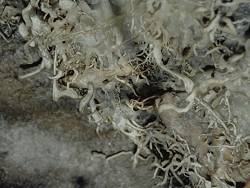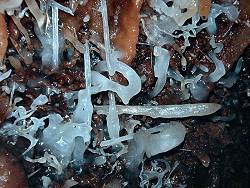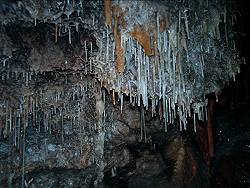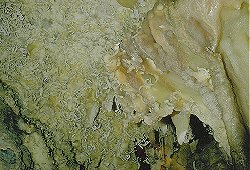Helictites
A speleothem based on calcite, which changes its axis from the vertical at one or more stages of its growth.
Helictites have a curving or angular form that looks like they had grown in zero gravity.
In rare cases they not only defy gravity, they grow through each other or seem to grow towards each other until they finally meet.
In most cases they are colourless, transparent or whitish and milky, in rare cases green or blue colours were found.
The name helictite is used in English, but many languages use adaptions of the French term excentriques (eccentric).

 Buchan Caves in Australia. (© Mathias J. Duckeck)
Buchan Caves in Australia. (© Mathias J. Duckeck)
 Temple of Baal Cave, Buchan, Australia.
Temple of Baal Cave, Buchan, Australia.Helictites are composed of calcite, in other words dripstone or flowstone. This calcite is deposited when water looses the ability to keep the limestone dissolved, which in general is because of the loss of carbon dioxide. As water drips from the ceiling and hits the floor, it forms vertical stalactites and stalagmites. When water stands still in a cave lake it forms rims, dams and crusts. Helictites differ from all those forms of speleothems. They look similar to small stalactites and soda straws, but with a strange specialty, they are twisted and torn. Some look like horizontal stalactites, some are bent like a corkscrew.
Helictites are made of calcite, they should not be mixed up with aragonite speleothems which have a completely different origin. Helictites are often transparent, like window glass, and they may have blue or green colours which are sometime easy to explain with colouring copper minerals. But even here are enigmatic cases of untypical colouring, in comparison to flowstones nearby. Its quite astonishing that helictites have a different colour despite being precipitated from the same water, the same solution with the same impurities.
The growth of helictites is still very enigmatic. Until now there is absolutely no theory which really explains how they are formed, just a bunch of hypothesises. The main ideas are wind and capillary forces which both influence the direction of growth. A new theory which explains many details is by biologically-mediated processes. At the moment it looks like there are different helictites formed by different mechanisms or a combination thereof.

 Royal Cave, Buchan Caves, Australia.
Royal Cave, Buchan Caves, Australia.
 Grottes des Tunnel, Ardeche, France.
Grottes des Tunnel, Ardeche, France.
 Timpanogos Cave, Utah, U.S.A.
Timpanogos Cave, Utah, U.S.A.
According to the generally accepted theory capillary forces are the most important mechanism in the formation of helictites.
If the helictite has a very thin central tube where the water flows like in
 straws, capillary forces would be able to transport water ignoring gravity.
Normal straws have too thick holes, capillary forces work much better with very narrow cracks or capillaries.
This theory was inspired by some hollow helictites.
The problem with this theory is, that most helictites are definitely not hollow.
straws, capillary forces would be able to transport water ignoring gravity.
Normal straws have too thick holes, capillary forces work much better with very narrow cracks or capillaries.
This theory was inspired by some hollow helictites.
The problem with this theory is, that most helictites are definitely not hollow.
Another theory names the wind in the cave as the main reason for the strange look. Drops hanging on a stalactite are blown to one side, so the dripstone grows into this direction. If the wind changes, the direction of growth changes too.
This theory is very problematic, because wind directions change very often.
The wind in caves depends on air pressure changes outside, which are depending on the weather (see
 Blowholes).
So the wind direction changes either twice a year or as often as the weather conditions outside change, depending on the cave type.
But the dripstones grow very slowly, a few centimeters in 100 years.
So the direction would change every fragment of a millimetre.
To form a corkscrew with a diameter of 10 centimeters, the wind has to change its direction almost continually and very slowly for thousands of years.
Blowholes).
So the wind direction changes either twice a year or as often as the weather conditions outside change, depending on the cave type.
But the dripstones grow very slowly, a few centimeters in 100 years.
So the direction would change every fragment of a millimetre.
To form a corkscrew with a diameter of 10 centimeters, the wind has to change its direction almost continually and very slowly for thousands of years.
Also, the wind is often the same for all helictites in a small area, so they should show comparable form, which is not the case.
A third problem with this theory is that many caves with helictites never had a natural entrance, and as a result never had wind. Helictites are often found in remote parts of caves, where no wind at all can be found, but wind strong enough to move water drops would have been necessary.
And finally, there is the problem that many helictites grow horizontally out of the wall. Where should the wind come from to create this, out of the rock?
A new theory which is inspired by new developments in the discovery of nano-bacteria and extremophiles in caves states biologically-mediated processes as origin. In other words, the deposition of calcite is a result of biological processes and so the helictite grows where the nano bacteria "wants". If you deny those bacteria intelligence or self-consciousness, you might call it the biological needs of the organisms.
Microanalysis and molecular-biological investigation revealed the presence of a prokaryotic biofilm intimately associated with the mineral structures. Microbially-influenced mineralization serves as a nucleation site for calcite. This theory is quite young, see the publication listed below from 2015. At the moment, it seems this is the most probable of all theories.
Nevertheless, the way helictites are really formed is still unknown. This is definitely the most enigmatic and interesting problem in speleology.
Related is the term heligmite, which refers to helictites that grow upwards from the cave floor or thin stalagmites that look like eccentrics. It’s a try to make the stalactite/stalagmite distinction as helictite/heligmite. But since helictites generally grow in all directions, the distinction between those growing upwards and those growing downwards makes no sense.
-
Nicola Tisato,
Stefano Torriani,
Sylvain Monteux,
Francesco Sauro,
Jo De Waele,
Maria Tavagna,
Ilenia D’Angeli,
Daniel Chailloux,
Michel Renda,
Timothy Eglinton,
Tomaso Bontognali (2015):
Microbial mediation of complex subterranean mineral structures
Scientific Reports. 5. 10.1038/srep15525. ResearchGate - Carol A. Hill, Paolo Forti (1997):
Cave Minerals of the World,
National Speleological Society, ISBN: 1879961075, 2nd edition (1997), hardcover, 463 pages
 at Amazon.com
at Amazon.com
- Jill Rowling (2000): Cataloguing Helictites and other capillary-controlled speleothems, In: C. Brown [ed], Proceedings of the 23rd Australian Speleological Federation Conference, Bathurst, NSW. ASF, Broadway. pp. 46-56, 2002. online.
- Adrian Immenhauser, Rene Hoffmann, Sylvia Riechelmann, Mathias Mueller, Dennis Scholz, Stefan Voigt, Stefan Niggemann, Dieter Buhl, Maximilian Dornseif, Alexander Platte (2022):
Petrographic and geochemical constraints on the formation of gravity-defying speleothems,
The Depositional Record, Volume 9, Issue 3, Special Issue: Carbonate Diagenesis: a celebration of the work of J.A.D. (Tony) Dickson, May 2023, pp 413-436. DOI
 Search DuckDuckGo for "helictite"
Search DuckDuckGo for "helictite" Helictite - Wikipedia
Helictite - Wikipedia
 Index
Index Topics
Topics Hierarchical
Hierarchical Countries
Countries Maps
Maps